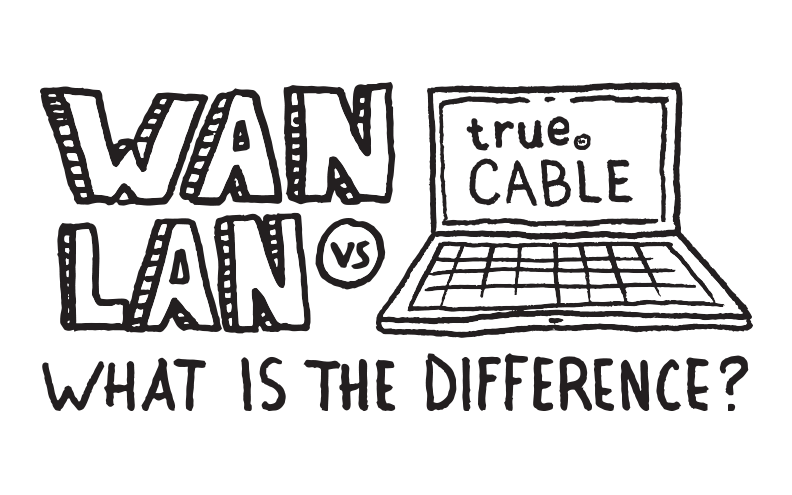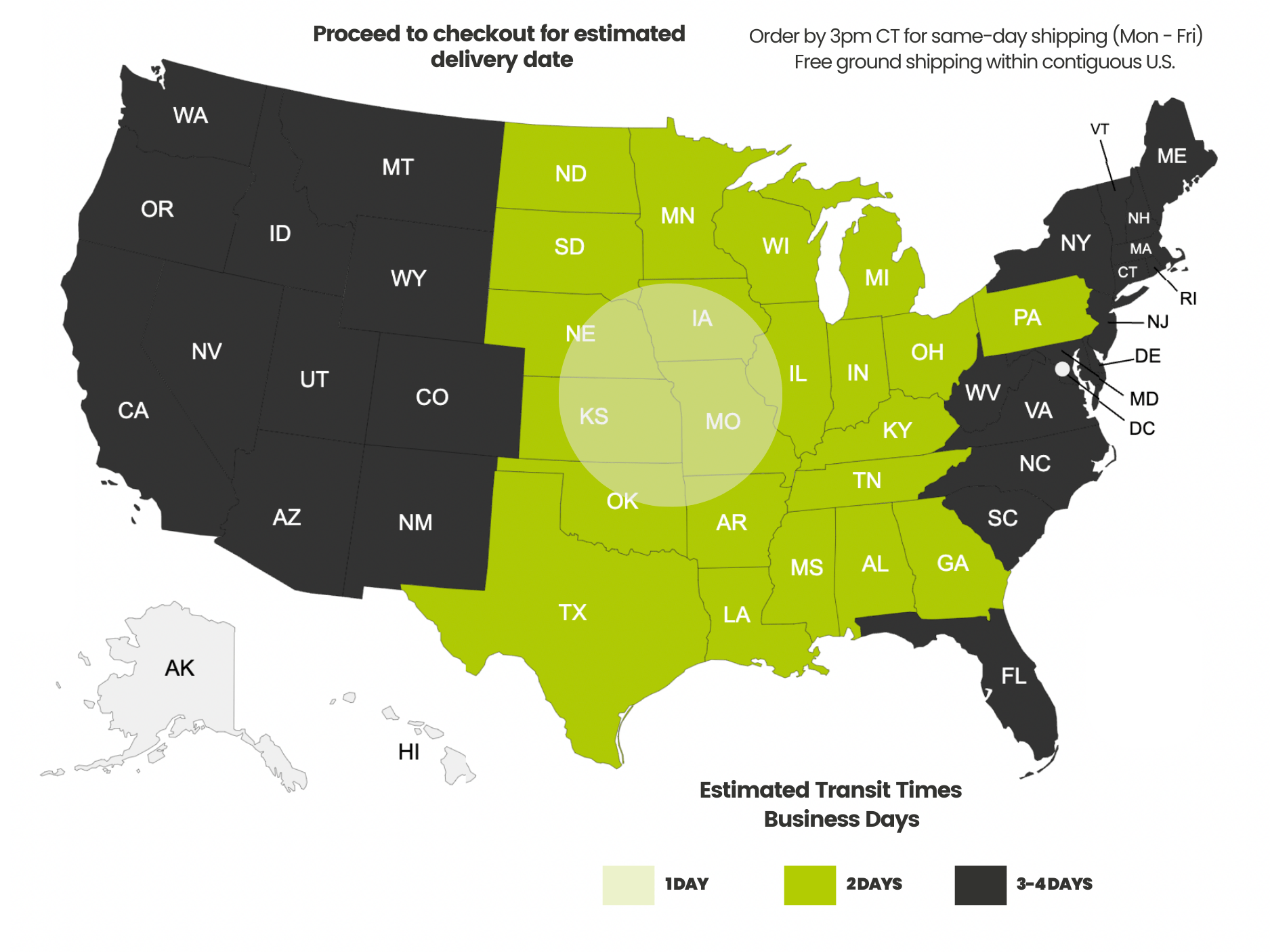Payment methods accepted

WAN vs. LAN: What Is the Difference?
Written by Don Schultz, trueCABLE Senior Technical Advisor, Fluke Networks Copper/Fiber CCTT, BICSI INSTC, INSTF Certified
Quick exercise. Connect your phone to WiFi and then browse over to your favorite website. How did everything go?
Congratulations! You just used a Local Area Network (LAN) and Wide Area Network (WAN) network and perhaps did not even realize it. How did that happen? You connected first to a LAN and were then forwarded to and from a WAN, which in this example was the Internet.
There are many fancy networking terms thrown around that you may not be completely familiar with. If you are like 99 percent of the world’s population, you don’t actually care what they mean. You just want the LAN and WAN networks to work.
If your Internet surfing brought you to this blog, intent upon finding out exactly what makes a LAN different from a WAN, please read on.
What You’ll Learn in This Blog
- You will learn what attributes characterize a LAN
- You will learn what attributes characterize a WAN
- You will be able to articulate the similarities and differences between LANs and WANs
- Your understanding of how LANs and WANs interact with each other will increase
What Are LANs and WANs?
LANs and WANs are different types of communications networks, typically separated logically and often physically. These networks may or may not interact with each other to increase resource access, depending upon the specific purpose. It should be noted that without LANs, WANs could not exist. Interesting statement there. Let’s explore further to find out why.
What Is a LAN (Local Area Network)?

Simple LAN, with connection to the Internet. Image courtesy of Cloudflare.
LANs are Local Area Networks. Here are some typical LAN characteristics:
- LANs typically physically connect using Ethernet cabling and WiFi signals.
- Normally, LANs are extremely fast. LAN speeds vary upon the various devices connected together, but speeds of 100Mbps to 10Gbps are common.
- Given that LANs are local to you, and under your control, LANs are typically extremely reliable.
- LANs can be super easy to construct. All that is needed is an Ethernet router, Ethernet switch, and some way of connecting to the LAN with a client device. A simple home all-in-one WiFi router combination is an example of a LAN in a single box. It does not get simpler or easier than that! Of course LANs can get a LOT more complex due to scalability -- all you need is more money for more equipment and installation supplies! If you want to go really fast then construct your LAN with fiber optic cable.
- LANs are easy to maintain as no travel is required to upgrade and troubleshoot them.
- LANs can be constructed in such a way as to be very secure, depending upon requirements. All equipment is on-site and control is local to you, so you get to control how secure the LAN is. A super secure LAN uses wired networking exclusively, and may not even allow Internet access!
See the FAQ section for definitions of terms like “router” and “Ethernet switch”, which may be unfamiliar to you.
What Is a WAN (Wide Area Network)?

Simple WAN, connected via MPLS. Note all LANs have Internet access as well.
Image courtesy of Cloudflare.
WANs are Wide Area Networks and interconnect multiple LANs. Here are some typical WAN characteristics:
- WANs cover intermediate to large geographical areas, often linking multiple LANs in large corporate or educational networks.
- WANs use public infrastructure to transmit data over leased lines (largely phased out), ISP provided MPLS WAN services (Multi Protocol Label Switching), or via another even larger WAN such as the Internet via VPN (Virtual Private Network).
- Typical WAN speed is 150 Mbps and higher. Some WANs can reach 1 Gigabit speeds.
- If MPLS WAN services are leveraged to create the WAN, efficient data transfer is possible but such services are expensive to set up and maintain.
- WANs are not as secure as a LAN because the data is being transmitted over infrastructure the corporation or educational institution does not own, whether via MPLS or stand-alone VPN tunnels. Whether encrypted or not, the data transmitted over the WAN can be intercepted.
- WANs are not as reliable as a LAN. They rely on common public infrastructure while LANs can be controlled from within a corporation. WANs are at the mercy of weather, other companies technical issues, a contractor’s shovel when digging, and possibly gremlins.
The ultimate example of a WAN is the Internet.
Key Differences Between LAN and WAN
Geographical Scope
LANs are networks seen in homes and businesses, or on college campuses. The key idea is LANs are confined to a single structure, or perhaps several structures located in relatively close proximity. WANs may span the entire globe, with no geographical limitations.
Speed
LANs are often quite a bit faster at transmitting data. LAN speeds can easily reach 100 Gbps or even faster. WAN speeds will be limited by the ISP’s public infrastructure, whether over MLPS or individual VPN tunnels. Speeds for WANs are often 1 Gbps or less, but faster speeds are coming soon. See Fiber Optic Internet: The Future of High-Speed Connectivity for more information on just how fast data is likely to go in the near future!
Security
LANs can be set up in such a way that they are highly secure, without access to the outside world via the Internet. Yes, such LANs exist for corporate R&D secrecy, or governmental secrecy (think military installation). Even with Internet access, LANs are characterized by a high degree of potential security making use of packet inspection firewalls and complex passwords for WiFi using WPA2 or WPA3 encryption security.
WANs by default use infrastructure that you do not own (but rent or lease perhaps). This creates the potential for data interception. VPNs alleviate this greatly due to an encrypted tunnel encryption, but hacking is still possible as technology evolves.
Cost
LAN costs will depend upon the initial size and scalability needs of the network. Whether using copper twisted pair Ethernet or fiber optical cable or a mix of the two, a LAN can be constructed in a number of ways.
Costs for WANs can be reduced by utilization of the Internet with encrypted VPN tunnels, although this limits scalability since VPNs are individual point-to-point connections. MPLS WAN costs can get quite expensive due to data costs, caps, and rental fees -- but may be the only option if multi-point connections are needed.
Reliability
LANs are significantly more reliable than WANs. LANs are controlled locally, where various forms of security can be employed to protect them. In addition, power backup and other forms of redundancy are easily deployed to keep your local area network operational during a weather incident where this may not be possible at any price for the typical WAN.
How LANs and WANs Work Together
Let’s describe how your LAN works together with the Internet, an experience that everyone can identify with. The Internet is the biggest WAN in the world. It is the perfect example of Wide Area Networking because it allows you to escape your Local Area Network and visit websites that are not inside your home. They may not even be in your country for that matter, and that is why the Internet is a beautiful thing. That all said, the Internet is not the only WAN around. The question is, how does this all work so seamlessly?
Every computer, tablet, phone and more that is able to access your local network (wired or WiFi being equal for this discussion) has what is known as a NIC or Network Interface Card. The NIC permits you to connect to other devices in your LAN like printers and other computers. In charge of keeping this all organized and sorted out is your router. Routers, by definition, provide DHCP or Dynamic Host Configuration Protocol services that assign a unique local and private network address (called an IP address) to each and every device on your network. No two devices can have the same address! Now, even though you can connect to your local network and talk to other devices it does not necessarily mean you can access the Internet. That costs money, and requires another piece of equipment; specifically it requires yet another rather specialized NIC.
So, now we take this discussion (logically speaking) up a level to the Internet itself. Your Internet Service Provider (ISP) likely is renting you a cable or fiber optic “modem”. That ISP provided device is actually the specialized NIC that allows you to interface with the outside world. Also known as a “gateway”, your cable modem allows the jump from your internal network to the outside world. That cable modem provides you with a (typically singular) public IP address. Think of your public IP address as equivalent to your street address. No two public IP addresses can be the same.
Your local router, being smart and all, will recognize the ISP NIC (aka “cable modem”) and provide NAT or Network Address Translation between your local private IP address network and your public IP address. The router, again being smart and all, also makes sure all devices communicating out to the big Internet get the right data they requested back without exposing your local private address to the entire world. That is how you can watch streaming content on your TV while someone else in the house can surf the Internet and while yet a third person may be gaming online.
Without a router to keep everything organized, your local network and therefore communication with the Internet would grind to a screeching halt and be very messy.
FAQs About LANs and WANs
What is an Ethernet switch?
Ethernet networks are known as “packet switched” networks where a switch communicates with individual devices over individual cables using IP addressing. A network switch is required for wired Ethernet networking and for expansion of the network to additional switches and therefore additional end devices. An Ethernet switch works in combination with a router and they are often combined into the same piece of equipment.
What is an IP address?
An IP address stands for Internet Protocol, and is a discrete and dedicated address assigned to a device on a network, normally via a router using DHCP. IP addressing is part of TCP/IP. TCP/IP means Transmission Control Protocol/Internet Protocol, and is a collection of protocols that define how networked devices communicate on a network, such as your local LAN or the Internet. TCP/IP also specifies how networks are routed and interconnected.
What is DHCP?
DHCP is defined as Dynamic Host Configuration Protocol and automatically assigns IP addresses to those devices that request them, requiring no user intervention. DHCP is part of TCP/IP.
What is a router?
A LAN router is technically a piece of software that routes Ethernet packets using TCP/IP, typically in conjunction with DHCP. This is normally plug and play, and the router provides your individual IP address on the network so your data is not confused with other data. Most people think of routers as a piece of hardware, but that is not technically correct although a dedicated piece of hardware may only perform routing (but they often do network switching as well, and maybe even have a WiFi hotspot integrated too!).
What is Ethernet?
Often confused and conflated with a specific cable type (specifically copper twisted pair Category cable), Ethernet is actually a protocol and the most basic level of communication on a modern switched network. The Ethernet protocol defines how data is formatted and transmitted. It also specifies the format of frames and packets, and how packets are forwarded.
Who invented the Internet?
It was not one person, and certainly not Al Gore. Two computer scientists, Vinton Cerf and Bob Kahn, are credited with developing TCP/IP as the basis for the Internet as we know it today. The Internet was an outgrowth of the Cold War, driven initially by the desire for high speed interconnections between Universities and military command structures.
Wrapping Up: LAN vs. WAN
Are LANs going to take over WANs or vice versa? Absolutely not. Is one better than another? LAN and WAN networks are not really comparable in this way. LANs and WANs each have their purpose. They have strengths, weaknesses and complement each other. In fact, without LANs you could never have WANs.
So, there you have it. Another burning question answered by the folks at trueCABLE. As always, HAPPY NETWORKING!
Ready to Learn More?
trueCABLE’s Cable Academy has a wealth of information providing educational materials covering general topics like this one but also takes many deep dives into copper Ethernet, coaxial, fiber optic cable, and more! Take a look as you will be glad you did!
trueCABLE presents the information on our website, including the “Cable Academy” blog and live chat support, as a service to our customers and other visitors to our website subject to our website terms and conditions. While the information on this website is about data networking and electrical issues, it is not professional advice and any reliance on such material is at your own risk.



























